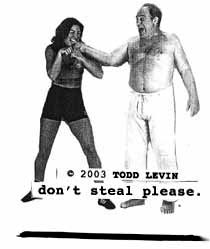


|
|
OBSESSIVE FOR 2002. In addition to my usual new year's resolutions - losing those extra 65 holiday pounds and trying to be less wack and more gangster - I have added a new mandate for myself: to become more obsessive. I have been thinking a lot about the nature of obsession lately and, unconsciously, I have sort of immersed myself in the obsessive work of others. The relentless pursuit of something to the point of practically embodying it is a quality i've lost touch with as an adult. When I was younger - beginning with pre-adolescence, I think - I loved certain things loudly and publicly. I loved human deformities, freaks of medicine and nature. I especially loved oral disfigurations. They were often the subject of my paintings and drawings and dinner conversation. It's probably a misplaced feeling, but I became very sentimental when someone would say "Oh! I saw this documentary on pinheads and thought of you!" Now I suppose I love things differently - maybe secretly and illicitly. My point is, when someone sees an African fertility figure they don't say "Oh! This reminds me of Todd!" My tastes and preferences have become cagier and perhaps a little bit more diluted as I shift the focus of my time to work, relationships, and alcoholism. We all do know people who we immediately associate with very specific sub-categories of knowledge or culture. This usually represents a projection of that person's obsessive charms. (and in some cases it represents a boorish self-absorption inflicted on everyone around that person.) The Web is full of obsessives. It's a convenient dumping ground for them. Unfortunately, the Web often produces the kind of weird, pedantic obsessive that no one really likes. The kind that collects Otter Pop packaging or back issues of TV Guide without really possessing any kind of point of view on either. "Obsessive" is too romantic a word to describe them. I would say this type of character is more of a "completist" or, more accessibly, a "person I hope to never share an airplane with." To distinguish the crazed heroes of obsessive tendency from the empty collectors, I have even fabricated my own personalized (and therefore limited) definition of what I think obsession should be: the indefatigable drive to measure every dimension of an immeasurably small piece of knowledge, regardless of whether or not that knowledge is based on a true and rational assumption. Defined conveniently and thusly (I felt it important to use the word "thusly" in this particular context), obsession is extremely desirable to me. Here are two specific examples of the real kind of obsessive character, from my own recent, awestruck observations. The first was the Henry Darger collection I saw on exhibit at the Museum of American Folk Art in New York City. Darger was a brilliant, crazy recluse, and the rarest (and my favorite) kind of artist - the kind whose art completely lacks self-consciousness, coming from an uncontainable internal force without any trace of desire to be seen as an artist. He worked because he had to: his art was necessary to fully explore a geography and history of his own creation. Before ever viewing his illustrative paintings, bulging manuscripts, and elaborate tracing studies you can simply read a few casual observations about his life and already begin to understand his totally obsessive nature. But you should see his art anyway. Darger's hundreds of watercolor paintings were intended as illustrations for his great life's work, a 30,000 page manuscript (in 15 volumes, though the length and number of volumes seems to change depending on the source) entitled The story of the Vivian Girls, in what is Known as the Realms of the Unreal, of the Glandeco-Angelinnian War Storm, Caused by the Child Slave Rebellion. The title isn't as catchy as, say, Patriot Games, but Darger had a much more important undertaking than Tom Clancy. He was writing the rich, violent history of a world that no other human being has either seen or read about. His images are fantastical, perverse and extremely crowded - at one point, while viewing his collection, I attempted to count the number of figures in one of the paintings and stopped at 105. Other qualities of Darger's obsession I admired (for my own lack of the same qualities) include the following:
More recently, while in los angeles, I had a chance to visit the Museum of Jurassic Technology, which was incredible not only for its unique collections but for its sheer ambition. One bit of subtext that repeated itself from collection to collection was the scientific study of seemingly false knowledge. My favorite exhibition was the work of the 17th century scholar Athanasius Kircher, whose research began with the nature and behavior of magnets and slowly became something completely other. As the museum describes him, Kircher was an inventor, composer, geographer, geologist, Egyptologist, historian, adventurer, philosopher, proprietor of one of the first public museums, physicist, mathematician, naturalist, astronomer, archaeologist, and author of over 40 published works. He theorized about magnetism as it relates to the rotation of the planets around the sun - claiming the sun itself was a gigantic magnet, creating a tight magnetic field of rotation in which the nine planets in our solar system, each with magnetic properties of their own, orbited. Later, however, he occupied himself with even more impractical matters, such as disputing the physical dimensions of the theoretical Tower of Babel (a tower which could be built to reach heaven from earth). Kircher's most interesting product of his obsessions was, in my opinion, his theory that the world is bound in "secret knots", in which he asserted that all behaviors, actions, patterns, etc. in humankind and nature are the result of magnetic forces. The tide? Magnets. Storms? Magnets. My love of sloppy joes? All thanks to magnets. The conclusion of his proof - that everything occurring in the world is bound to and mirrored throughout the whole of creation - is an ironically religious (and specifically eastern religious) one. And it only took this Jesuit 40 books and countless constructed models to get there. After writing this, I would actually like to revise my new resolution for 2002. I would still like to become more obsessive, at least about my creative work, but without taking on the additional burden of being totally insane. I suppose that's an important distinction.
|
